Teaching is an exciting but challenging experience. Most teachers want to maximize their effectiveness and minimize the likelihood of behavior problems within a classroom setting. But to achieve all these goals, a teacher must be able to guide their class. Creating a well-developed management plan for the classroom can help maintain order in any class and ensure that students receive a beneficial education.
This article will provide valuable insights into creating management plans, including the benefits of having such a document, elements to include, and how to implement the plan successfully. We will also provide you with free and customizable templates that you can download to help you create your management plans quickly and efficiently.
What is a Classroom Management Plan?
A classroom management plan is a document that lays out specific rules, consequences, procedures, and methods to help students learn and behave in the classroom.
The teacher outlines their expectations for student’s behavior and academic performance and provides clear instructions for managing and regulating class activities, which provides some form of structure and promotes a positive learning environment for students. Teachers need to create such a document to be prepared should any situation arise in the class. Creating this plan of classroom management also allows teachers to fine-tune their methods and improve interactions with their students to positively affect students’ behavior.
What are the Benefits of a Classroom Management Plan?
This plan allows teachers to be prepared for any situation in class and ensure students receive an adequate education through some structure. For example,creating a clearly defined set of rules and consequences allows teachers to inform their students explicitly and implicitly about what is expected of them.
Consequences outlined in the management plan are usually contingent upon the behavior exhibited by the student. Clear, logical consequences have also been proven to be more effective than vague or undefined consequences. In addition, establishing a structure of rewards and punishments allows teachers to maintain student behavioral codes and sets expectations.
A well-formulated management plan improves student participation and leads to better retention of information. The plan also reduces teaching-related stress. It provides teachers with a written set of rules, procedures, and consequences to follow when students exhibit undesirable behaviors or fail to meet the assigned criteria of a lesson. This allows them to address disruptive student behavior quickly, efficiently, and fairly, resuming normal class activities shortly afterward. The management plans also promote positive interactions between students and improve attendance, enhancing academic success.
Elements to be Included in a Classroom Management Plan Template
These templates vary significantly in terms of content and structure. This is usually the case because these plans are dependent on the unique needs of an individual classroom, i.e., the physical environment of the class and class level, as well as the overall school policy. Nevertheless, a template should address a few standard elements in every classroom management plan.
These include:
Classroom rules
These rules are behavioral norms that guide and direct student actions in the classroom. These rules serve as the mechanism through which students must conform to maintain the desired level of behavior and discipline. The rules should be clearly defined, concise and specific. They should also be based on student behavior, i.e., what is expected of students and what actions will be taken against any activity or performance that does not conform to expectations.
To foster positive interactions with your students and promote a healthy learning environment, consider phrasing the classroom rules as something you want students to do rather than what you don’t want them to do.
EXAMPLE
Instead of including a rule saying “Don’t run in the classroom” in your template, consider a rule that states, “Walk quietly to your desk.”
Classroom procedures and routines
These are the practices that help establish a standard in the classroom. They should be presented to students concisely, providing enough detail to ensure that the students know what is required of them at specific time frames. For instance, you may establish a morning routine that includes calling the roll, reviewing homework and objectives for the day, or greeting students as they enter the class.
EXAMPLE
Example of a classroom procedure is a weekly bulletin informing students of the upcoming day’s schedule, including all-day assignments, lunchtimes, field trips, events, and responsibilities for various grades.
Procedures and routines promote consistency in class and enhance student engagement by reinforcing expectations through repetition; thus, they should be clearly outlined in a standard management plan template.
Set clear expectations
A teacher’s job is to foster a healthy, productive learning environment.To accomplish this goal, you must set clear expectations for your students by clearly outlining what is expected of them. This includes both the accepted behavioral expectations and academic performance standards. You should also set specific goals that align with the lessons you plan to cover during your class period and define the criteria students must meet to attain these goals.
EXAMPLE
All students must adhere to all classroom procedures and routines and be punctual to my class.
Physical environment and lesson plans
A classroom environment is a crucial element in ensuring effective student learning, and therefore this element should be provided for in your preferred management plan template. The physical components of the classroom, such as desks, chairs, and tables, should be arranged in a way that fosters student engagement and creates an aesthetically pleasing environment.
In addition, your lesson plans and activity worksheets should be designed to allow the students to learn and retain educational information. The lesson plan should also include a set of criteria for evaluating student engagement and performance during class activities and clear instructions on how to move forward with the activity.
Student jobs
Effective management plans for the classroom must be able to foster student accountability. Consider defining and assigning specific tasks and responsibilities for students to complete during class activities and record and track them in your template.
Each task should align with the lesson plans and classroom procedures or routines you have established in your template, and they should also be outlined in a classroom job chart such that students are aware of what they are responsible for during the class period. Student jobs may include simple duties such as leading a discussion, helping with clean-up after a class activity is completed, or simply having a different student greet everyone at the door each day.
Other proven methods for nurturing and promoting accountability amongst students include having students reflect on their participation and behavior after every class activity and allowing them an opportunity to self-regulate or choose their learning adventure while operating within the established norms.
EXAMPLE
Students may be allowed to choose their seating arrangement in the classroom or select the order in which class activities should be carried out.
Emergency procedures
This template should also contain contingency procedures that address any emergency or significant disruptions during class. This includes procedures for responding to fire, tornado, floods, and student illness.
EXAMPLE
If there is a fire breaks out in the school, you should have a straightforward procedure for safely evacuating the students, including procedures for students with special needs.
Detailing the steps you want your students to follow in the event of emergencies and practicing the various emergency protocols before they occur will ensure that your students are familiar with them; hence when an emergency occurs, they will be able to conduct themselves accordingly.
Decide on consequences
A management plan template for the classroom should also include a set of consequences that will be applied to any student who violates the rules. There are various types of consequences to include in the management plan depending on the severity of the offense. Their application must be proportional to the type of behavior or event to foster consistency.
While deciding on the consequences, consider positive behavioral change reinforcements, such as positive remarks to encourage engagement and productivity, and giving out rewards or praise instead of punishment. However, if you are forced to use negative consequences to reinforce behavioral change among specific students, consider implementing measures that are safe for the students and respect their dignity and fundamental rights. Moreover, consider involving parents when deciding the best course of action.
Classroom Management Plan Templates
A management plan is crucial for fostering a safe and productive student learning environment. It should include all the essential components to nurture and promote uniformity, accountability, and productivity among students. Of course, you can create your classroom management plan from scratch, but this can be a very tasking process.
Instead, consider using pre-designed templates given here to make your work easier and ensure that you include all the appropriate components. The templates are fully downloadable, and you can personalize them to meet your unique teaching styles and class objectives.
In addition, these templates are created following the techniques that are proven to work for various classroom settings and levels. Therefore, you can constantly update them without having to create a new template each time.
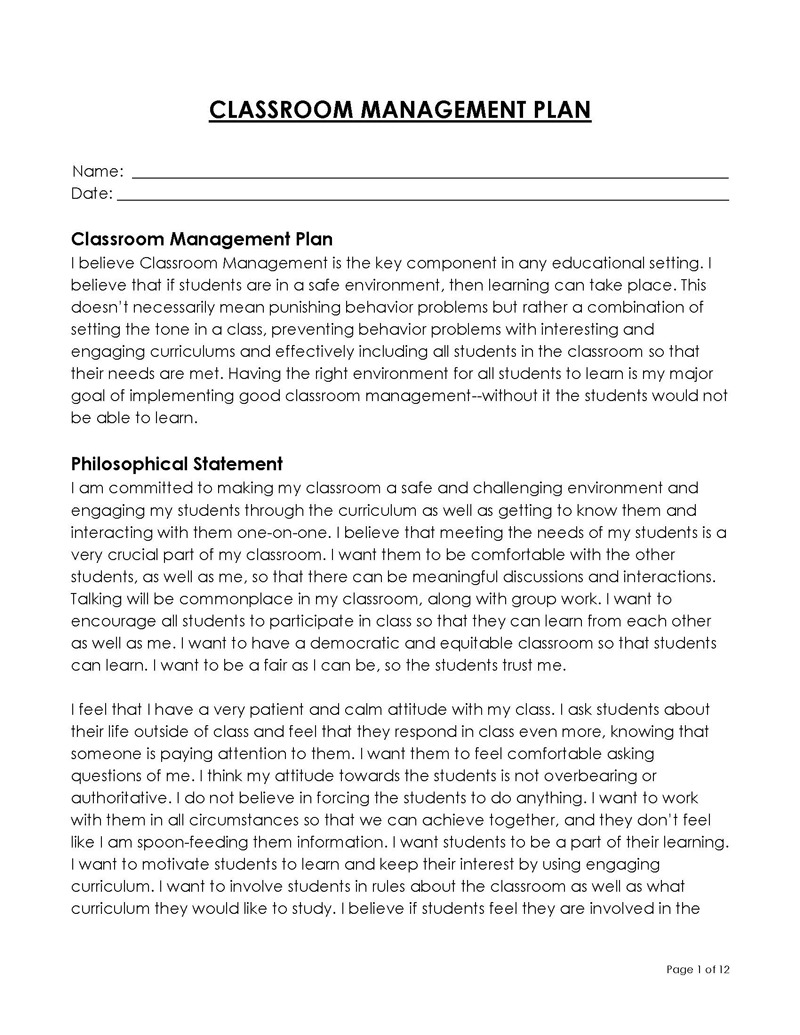
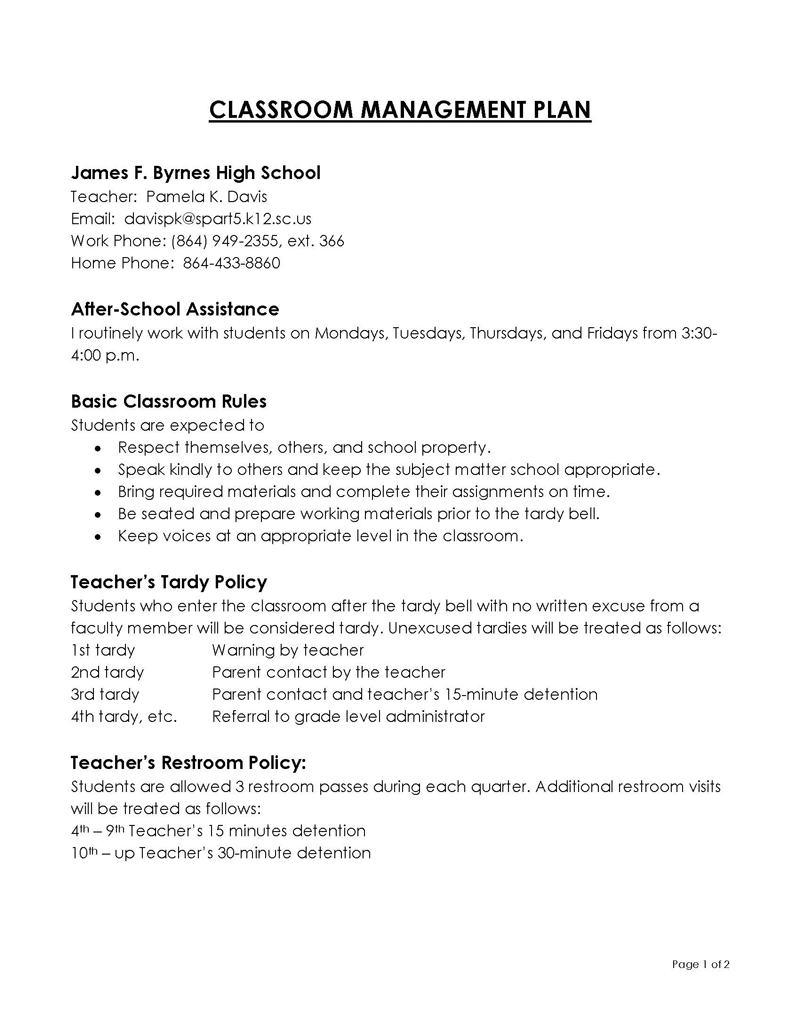
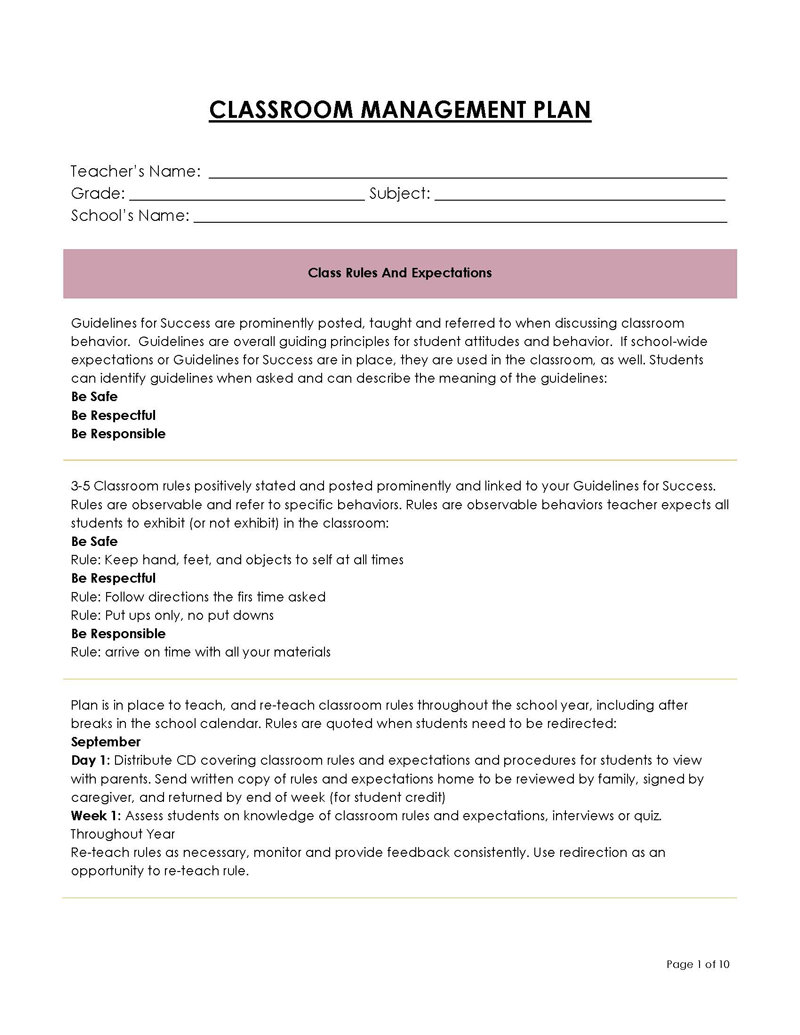
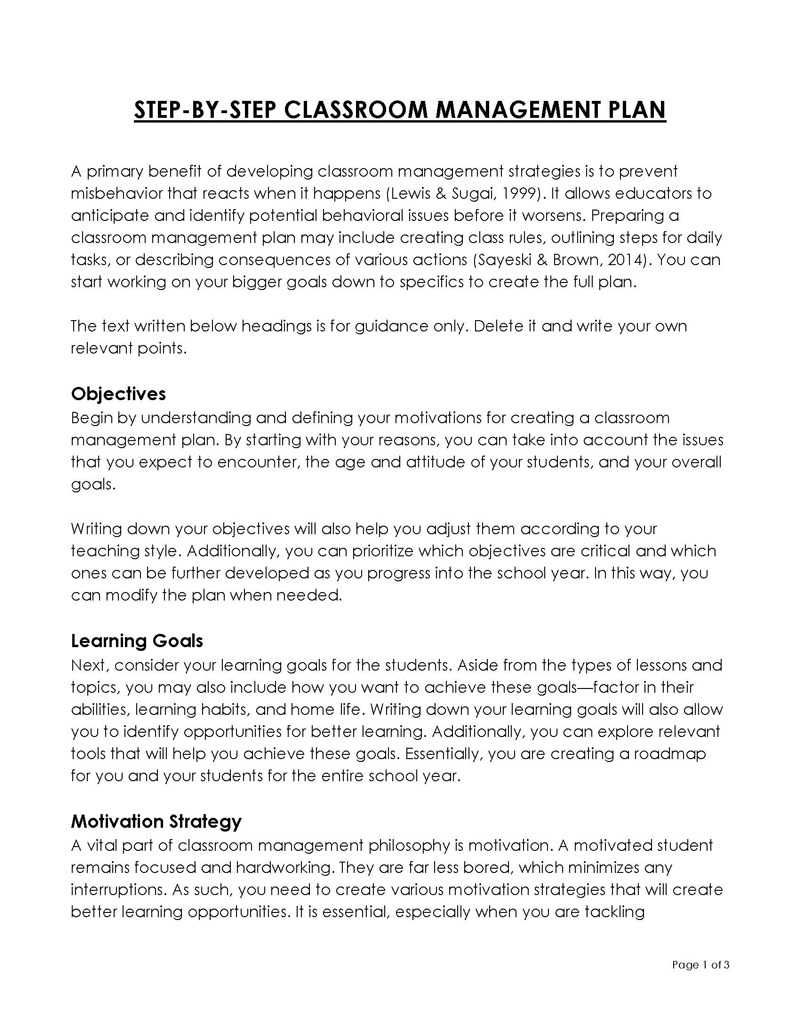
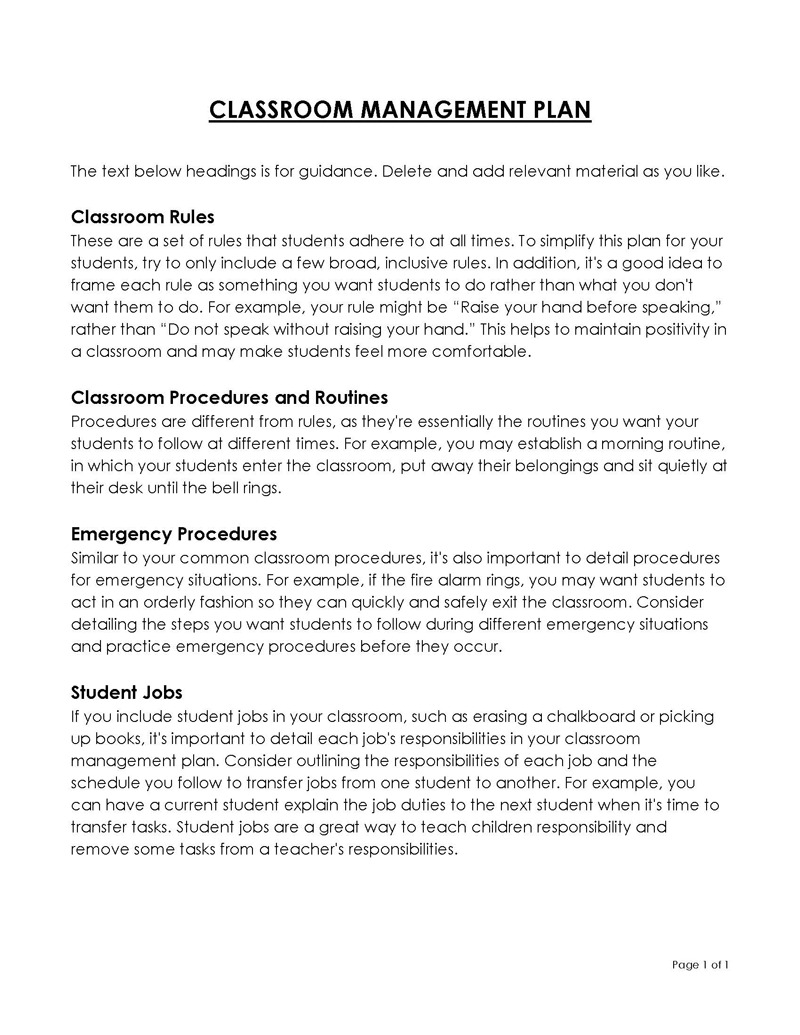
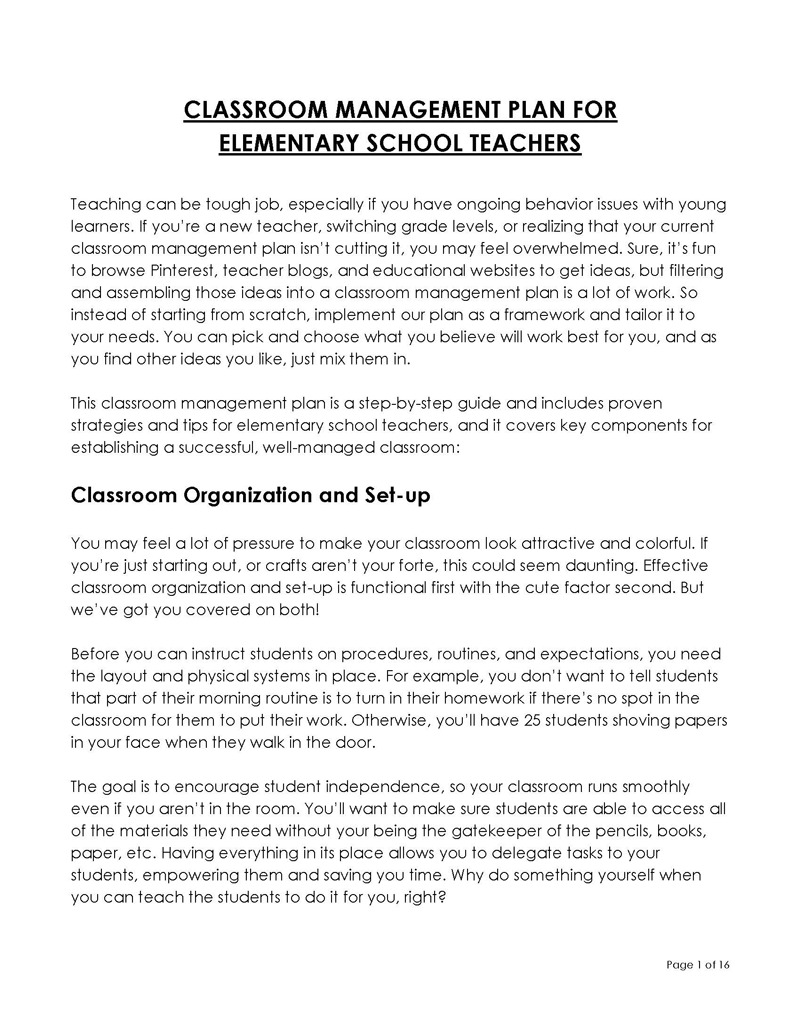
How to Implement a Classroom Management Plan
Once you have created a template that includes all the essential components, the next step is to implement it. The implementation part may prove a bit challenging, especially if you have never created a management plan for a classroom before, but the following valuable tips can help:
Identify school policies
To ensure that your management plan for the classroom is fully compliant with the already established school policies, you must first be conversant with these policies before creating a plan of your own. By referencing the established school’s policies and set criteria for managing overall student behavior, you can incorporate your personal philosophy and values in the management plan without deviating from the school’s regulations, thus eliminating behavioral inconsistencies among students.
Consider all possible scenarios
It would be best to create your plan before the beginning of the school year. If possible, determine how you want to respond to various classroom management scenarios before they occur. This allows you enough time to revise the plan if you identify any areas that need improvement. In addition, consider consulting other teachers and colleagues who may have previous experience with management, as they can provide you with valuable tips.
Introduce the plan early
Make it a point to introduce the plan when the school year begins and classes start. This will enable you to evaluate the student’s reactions regarding the plan and its effectiveness in reinforcing desirable behavior amongst your students. If any areas need improvement, you can devise and implement additional strategies that will help maintain a positive learning environment.
Post your classroom norms
Posting the management plan in the classroom is a very effective way of reinforcing positive behavior and educating students about the desired behavior. Post the rules on your classroom walls and communicate them to your students such that all your students are aware of what is expected of them and are on the same page. Posting your classroom norms in visible places may also reduce the time and effort needed to establish firm behavioral standards and help you maintain consistency with any consequences applied.
Get to know your students
Your lesson plans should include a series of activities that will help you get to know each of your students better. This way, you can determine each of your student’s behavioral weaknesses and their strengths as learners. You can then formulate customized strategies to improve your student’s performance and behavior during class hours.
Create helpful visuals
If you have the artistic skills and time to do so, create helpful visuals that will help you encourage good behavior amongst students. These visuals can take the form of charts, posters, or any other exciting method that you can use to keep students focused on learning objectives.
Determine Your Reinforcements (Verbal and Non-verbal)
Use both verbal and non-verbal communication to reinforce academic and behavioral performance.
EXAMPLE
When a student exhibits positive behavior, show them that you recognize it by praising them sincerely. This way, you will inspire the class, reinforce the values and rules you want to see, and improve the student’s self-esteem, encouraging your students to repeat similar behavior.
You can also use non-verbal cues such as nodding, smiling, or clapping for a student who acts according to your expectations. On the other hand, students who misbehave can be frowned upon, or you can shake your head at them, signaling them that you are unhappy with their conduct.
Distribute rewards
Issuing tangible rewards to specific students at the end of each lesson in front of the class is a highly recommended motivational and behavior-reinforcement technique.
EXAMPLE
Rewards can include allowing students who depict good behavior extra tablet or computer time, more rest time at the end of the school week, recognition stickers, or giving them raffle tickets that allow them to win a prize each week, such as being able to choose a game for the next class party, candy, etc.
Involve parents
Finally, it is also imperative that you involve parents by sending them a copy of your classroom management plan template. Let them know that they are free to suggest any other ideas that may help you maintain an organized and disciplined environment. If they don’t agree with any element of your template, consider revising it and modifying it accordingly.
In addition, if a student constantly fails to act according to the laid-out classroom norms and expectations, consider contacting their parent and discussing the best course of action to take to ensure you avoid conflicts with parents.
Key Takeaways
- A well-formulated classroom management plan significantly enhances prosocial student behavior, and academic engagement establishes an orderly and structured learning environment and reduces teaching-related stress and potential burnout.
- Effective management plans need to have established rules and consequences based on student behavior, including consequences for disruption and misbehavior, and procedures for reacting in emergencies. The plan should also foster student accountability and instill a sense of belonging among the learners.
- To effectively implement an established management plan, teachers need to identify school policies and ensure that their plan is compliant with the specific school’s policy, consult other teachers and ask them about their classroom management experiences and strategies, think about how they want to manage their specific class and devise measures and methods that can help foster a healthy learning environment.
- Informing parents of the established classroom code of conduct and giving them a stake in deciding the appropriate consequences for instilling discipline among students is also encouraged to prevent unnecessary parent-teacher conflicts.
- Finally, it is imperative to note that classroom management is a practice that changes from year to year with different students. Therefore, consider using a template that you can constantly edit to suit your unique class’s needs and teaching styles when creating a suitable classroom management plan. Also, please take note of the techniques that have been proven to work and include them in your plan to ensure that it effectively meets your objectives.




